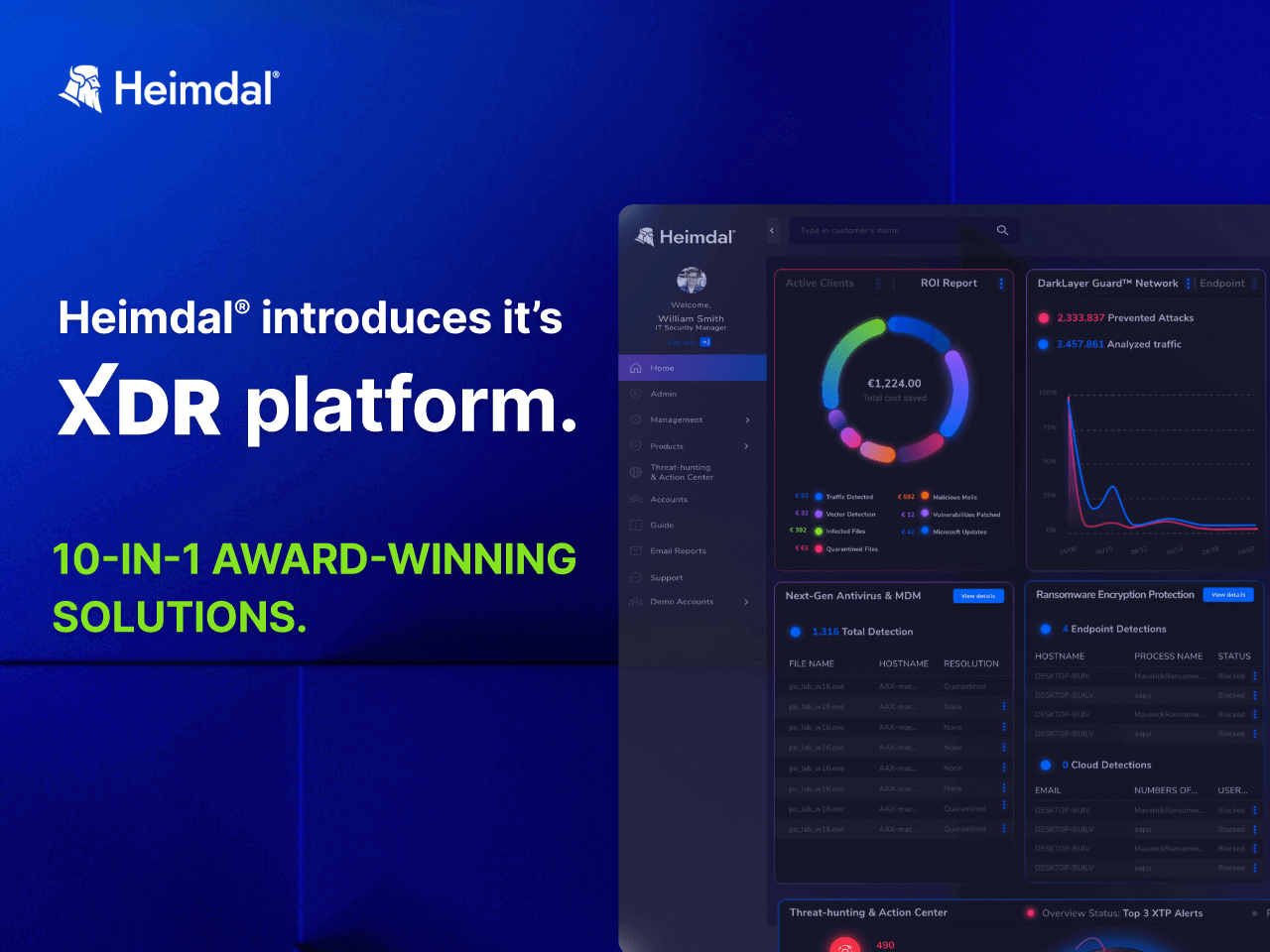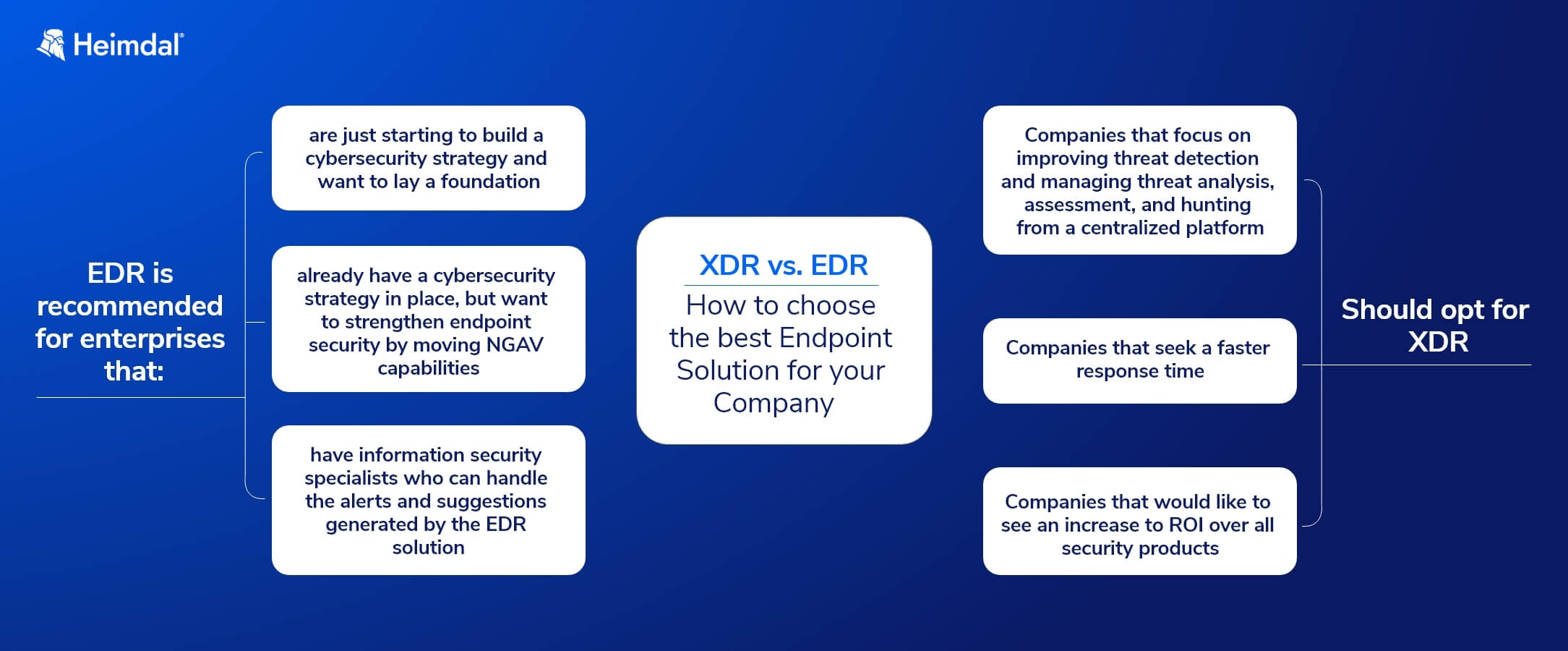Choosing between XDR and EDR is piece of cake, once you understand the scope, differences and capabilities of each solution.
Endpoint Detection and Response (EDR) tools only cover endpoint monitoring and responding to threats for devices. On the other hand, Extended Detection and Response (XDR) solutions provide network, cloud, and email security, besides safeguarding endpoints.
In this detailed analysis of XDR vs. EDR, I will explain how each technology functions. Comparing their strengths and weaknesses will help you make an informed decision.
Key takeaways:
- Understand the differences between EDR and XDR solutions
- Assess your infrastructure to choose the right endpoint security solution for your needs
- Explore XDR and EDR in Heimdal® Suite.
See Heimdal XDR in Action: Schedule a Live Demo Now!
XDR vs. EDR. Differences and benefits
XDR and EDR differ by coverage, integration capabilities and the depth of threat detection and response they offer.
While I’ll explain the differences between XDR and EDR, I’ll also highlight the benefits of each.
According to Gartner, XDR is “a comprehensive, cloud-native, and analytics-driven security offering that combines multiple security products.” Whilst that is true, my view is that to benefit and leverage XDR, you need those tools to be well integrated, which is not really what the Gartner definition says.
Also, the definition is quite vague, because typically those tools are mainly reactive, whereas (and incoming advertisement alert), the Heimdal stack is heavily focused on having a proactive, predictive security posture stopping threats before they come in, which no one else really offers.
Morten Kjaersgaard, Heimdal’s CEO
Integration and consolidation
XDR brings under the same umbrella various security tools, no matter what layer of defense they address. XDR integrates:
- EDR tools, like antiviruses, patch management, privileged access management, application control, etc.
- Network Detection and Response (NDR)
- Security Information and Event Management (SIEM) solutions
- Security Orchestration, Automation and Response (SOAR) solutions.
It gathers and analyses data from different security areas: endpoints, network logs, cloud workloads, and email. Thus, it consolidates the company’s security posture.
Best XDR solutions use analytics and machine learning to detect hidden threats. This integration improves threat detection and response, making XDR more effective than EDR. Its threat intelligence capabilities are simply better.
EDR does a good job at monitoring and safeguarding users’ devices. But that’s as far as it gets. Endpoint Detection and Response only integrates data that comes from endpoint security tools.
Its goal is to timely detect and respond to advanced threats that might harm an endpoint.
A Forrester report predicts that “by 2024, 50% of enterprises will have begun to consolidate their standalone security products, including EDR, NDR, and UEBA, into comprehensive XDR platforms.” This really supports my firm belief that the market will be evolving, but there are many different views on the matter.
One thing I would stress though to IT managers, CIOs, and general managers, is to make sure they get the necessary visibility of the risk, and to ensure the necessary actionability of threats.
Morten Kjaersgaard, Heimdal’s CEO

Advanced analytics and AI
Both XDR and EDR can use AI and machine learning to analyze data. AI-powered behavioral analysis helps detect threats early, by predicting potential malicious behavior.
XDR’s AI integration is stronger than EDR’s, because it has access to and processes more data. The big advantage is the variety of environments from which it gets those data.
Unified XDR platforms bring all the information under the same umbrella. This means full visibility across the environment, better cooperation between various tools and processes. The result is better security and less pressure on security teams. Why? Because XDR offers more context-aware alerts, thus minimizing false positives.
In your role as an IT manager, CIO, or CISO, you should aim to obtain actionability and proactive threat mitigation rather than reactive threat mitigation. Predictibility enables security teams to respond faster to security incidents.
Cloud-native security
Cloud-native security solutions are essential as more businesses use cloud computing and hybrid/ multi-cloud systems.
As opposed to EDR systems, which only focus on endpoints, cloud-native XDR expands the capabilities of existing XDR platforms to also cover:
- cloud workloads
- apps
- infrastructure
Choosing the Best Endpoint Solution
Legacy security is no longer effective. When choosing the best endpoint security solution you should mind several factors:
- The specifics of your infrastructure. Are you using more than one operating system? How many endpoints do you have to manage? Is your company’s work environment office based or rather hybrid or remote?
- Current threats have become more complex, and they keep evolving rapidly.
- Industry regulations. A well-chosen endpoint security tool can help meet compliance goals.
- The size, skills and expertise of your security team. What are your current detection and response capabilities?
Traditional security methods like antivirus software and firewalls sometimes fail against modern cyber threats. XDR addresses this by offering a unified view of threats, while EDR focuses on individual endpoints.
Additionally, XDR spans the gap between several security tools and offers a single view of the threat landscape.
So, which one fits your needs, XDR or EDR? Here are a few guidelines to help you decide between XDR vs EDR:
Choose XDR if:
- You want better threat detection and response;
- You’re looking for faster response times;
- You want better ROI on security products.

Choose EDR if:
- You are starting to build a cybersecurity strategy;
- You want to strengthen endpoint security;
- Your team can handle alerts and suggestions generated by the EDR solution.
External MDR / SOC / MXDR
The unified nature of a comprehensive XDR platform offers one more and last benefit, making it simpler for you to decide whether to internally or externally monitor the platform.
Given that XDR is only a technology and not a guarantee of accurate threat visualization, you must ensure that what you purchase also offers that.
Heimdal connects this to Threat-hunting and Action Center, the gold standard of straightforward cyber security management. You can also decide whether to monitor and act on the XDR discoveries yourself or to outsource them.
XDR and EDR in the Heimdal® Suite
Our XDR solution offers proactive threat intelligence and covers your entire security system. Heimdal’s XDR integrates security data from endpoints to networks, into a unified platform that’s both efficient and user-friendly.
This ensures real-time detection, data analysis, and automated response to sophisticated threats across your entire security architecture. Due to its outstanding integration capabilities, Heimdal’s XDR platform is a great choice for in-house security teams, managed service providers and managed security service providers.
Heimdal’s EDR combines six solutions in one. It’s efficient and won’t slow down your systems. Our customers, like NRGi, appreciate its all-in-one protection.
Here’s a product demo for you to check out:
What I like about Heimdal’s EDR product suite is that it offers all-in-one endpoint protection. By using it, I eliminated the need for any additional tools to protect company endpoints.
Heimdal is a completely unified solution that I am very happy with. In terms of how Heimdal improved our operations, if I take a look at my own department, namely IT, I can see that our team’s efficiency was considerably enhanced since we started using Heimdal.
Michael Warrer, Group CIO, NRGi
Our EDR software can prevent advanced ransomware, insider threats, admin rights abuse, APTs, software exploits, and brute force attacks. By leveraging the benefits of Machine Learning and AI-driven intelligence, it detects any other known or unknown threats at the endpoint level.
What Is XDR?
Extended Detection and Reponse is an integrated security solution. The abbreviation refers to a detection and response platform that protects the entire environment by adding multiple security layers.
This technology captures and analyzes data across multiple environments – endpoints, emails, servers, clouds, and networks – to enable proactive threat detection.
As cyber security expert Joseph Shenouda mentions,
With EDR, you’ve taken endpoint security seriously. Continued with XDR, you’ve now enlarged your vision to network activity as well. The goal ultimately is to respond automatically to identified threats.
What Is EDR?
Endpoint Detection and Response refers to a set of unified endpoint security solutions. Its purpose is to detect and prevent potential security breaches in real-time.
EDR platforms were designed to identify threats and actively respond to malware and cyber attacks on endpoints. Its key functions are:
- endpoint data collection
- data analytics and forensics
- threat hunting
- automated incident response
End-to-end consolidated cybersecurity; Complete visibility across your entire IT infrastructure; Faster and more accurate threat detection and response; Efficient one-click automated and assisted actioning
HEIMDAL® XDR Solution
Final Thoughts
XDR means taking things one step further and having much-needed visibility into all your attack surfaces. This way, when EDR starts to fade out, and XDR will be by far the fastest-growing market, you will have a big advantage.


 Network Security
Network Security
 Vulnerability Management
Vulnerability Management
 Privileged Access Management
Privileged Access Management
 Endpoint Security
Endpoint Security
 Threat Hunting
Threat Hunting
 Unified Endpoint Management
Unified Endpoint Management
 Email & Collaboration Security
Email & Collaboration Security










